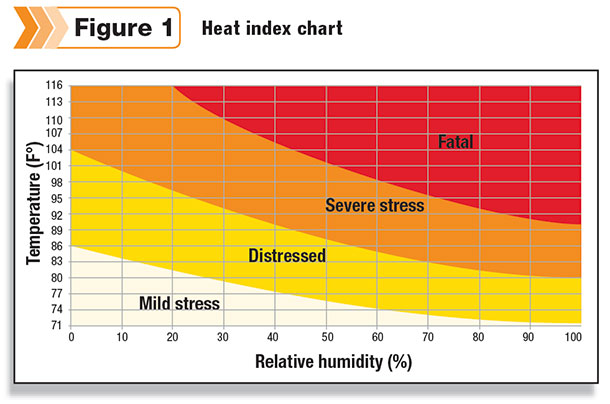Whether it’s natural or mechanical, barn ventilation is imperative when it comes to the welfare of dairy cattle. However, ventilation alone does not always provide the necessary air movement for cooling and comfort needs. Animals can intrinsically demonstrate their comfort levels simply by their eating habits, conception rates and milk production. Without a cooling breeze, the simple ventilation designed into a building isn’t enough.
A properly designed and equipped barn will not only allow an adequate air exchange rate but will also improve cow comfort.
To aid ventilation systems and supply much-needed air movement, fans are often brought in to circulate the air required to keep cattle comfortable.
Simply put, improving cow comfort increases milk production and profits. Studies at Kansas State University repeatedly indicate that adequate heat abatement in summer months results in increased profit of up to $120 per cow per year.
Through good heat-stress management, a 500-cow milking herd could generate an additional $60,000 net gain. Furthermore, reducing heat stress on your herd keeps reproduction at optimal levels. Adversely, without adequate air movement, heat stress tends to decrease milk production and the signs that indicate timely breeding.
Reduced lameness is another benefit noted by implementing proper air movement. By reducing lameness, cows keep their peak production levels longer, maintain higher yields throughout their lactations and have longer productive lives (on average, 1.3 lactation cycles).
With evenly distributed, comfortable air movement throughout a facility, cows are not forced to crowd or gather in cool spots. Furthermore, this even air distribution encourages cows to spend more time lying in their intended beds as opposed to standing closely together and putting unnecessary strain on their bodies.
Finally, air movement helps combat the presence of unwanted bugs and odors, reducing the chance of cows being affected by bites and diseases. All of these factors are key variables in controlling costs and increasing profits. Reducing herd lameness is also directly related to improved reproduction, essential to maximizing genetic investment and long-term farm growth.
Comfortable, adequate rest and easy access to fresh water and proper feed rations are important, and so is air movement throughout the facility to help ensure your herd maintains peak performance.
As a cost-effective alternative, the engineering behind properly designed high-volume low-speed fans allows dairy farmers to adjust the fan speeds and air velocities as needed. Constant air circulation provides much-needed air movement to help transition milk cows year-round despite seasonal changes and provides optimal cooling during the hottest months.
 For example, compared to traditional on/off high-speed fans, the variable speed control on these large-diameter fans allow the user total management of cow comfort needs.
For example, compared to traditional on/off high-speed fans, the variable speed control on these large-diameter fans allow the user total management of cow comfort needs.
More recent developments in fan technology allow these fans to operate without electromagnetic and radio frequency interference “noise” prevalent in older technology, thus causing no interference with electronic identification and robotic milking systems.
Positive effects of evaporative cooling for dairy cattle start to take effect during warmer months through the use of proper air movement. As the temperature-humidity index rises, air velocity needs to increase accordingly to maintain successful evaporative cooling – a method of cooling by evaporating moisture off the surface of the skin.
When considering a proper cooling system for your cows, it’s important to consider conditions of the herd in every circumstance from feeding to milking. With proper air flow, cows will no longer need to bunch together in the random breezy or cool spot and will be much more comfortable overall.
Poorly selected fan options could result in costly utility bills that force dairy farmers to postpone initiating cooling until later in the summer or completely dismiss the operation completely.
An air-moving plan with energy use in mind allows dairy farmers to provide better cooling with significantly less horsepower, providing a cost-effective, energy-efficient air movement method for dairy cow cooling while significantly improving milk production during the summer months.
One option dairymen can utilize to ease effects on production is the variable speed drive. Moreover, many dairy markets use utility suppliers that provide substantial credits or rebates for the installation of energy-efficient devices, reducing initial purchase costs and significantly increasing the return on investment.
Without effective freestall cooling systems, significant production and reproduction losses will occur. With the installation of a proper air-movement system, helping dairymen control costs and increase profitability does not stop at summer cooling.
Additionally, proper air movement can help reduce bedding costs in compost barns by keeping it free of moisture build-up. Moisture build-up can cause a variety of problems including the risk of slips and falls resulting in injury to cows and humans, an environment more susceptible to disease and bacteria and the need for bedding to be replaced more frequently. PD

Adam Hatton
Big Ass Fans






